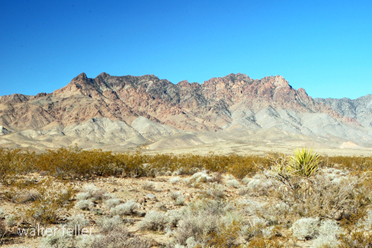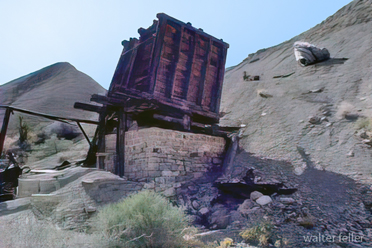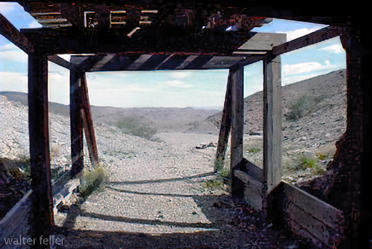Providence
Along the steep slopes of the Providence Mountains, south of the Clark Mining District, parties of prospects from Ivanpah found extremely rich silver ore during the spring of 1880. Some of the rock assayed as much as $5,000 a ton. The richest claim turned out to be the Bonanza King, which was sold to Jonas B. Osborne, H. L. Drew, J. D. Boyer, and Charley Hassen, all of whom had some knowledge of mining.Though a rich vein was found in early 1882, the owners of the Bonanza King sold their interests to the Bonanza King Consolidated Mining & Milling Company, of New York. The owners were Wilson Waddingham and Thomas Ewing, who had recently swindled investors in a mine in Colorado. They put at least 100 men to work round the clock, developing the mine. The company erected a 10-stamp mill at a spring on Juan Domingo’s ranch, a mile and a half from Providence. (The milling camp was known as Crow Town.) The mill started up on January 1, 1883. During its first six months, the mill produced $573,376 in bullion, according to mint reports. The company then put its stock on the New York mining exchange and began paying regular dividends. By early 1885, the main shaft of the Bonanza King reached 800 feet; the ore was worth as much as $100 in gold and silver. About 100 men worked at the mine and mill then. The company spent $20,000 on wages and supplies each month, whereas the operation was producing at least $35,000 a month. By then, the mill had produced $1,500,000 in bullion.
Meanwhile, Providence thrived. A post office was established in June of 1882, and in October, the county supervisors created an election precinct. By early 1883, the camp had 300 residents. The business district contained the post office, several mining-company offices, two general stores, two hotels (with livery stables), a saloon, a contractor, a blacksmith and wagon maker, a deputy sheriff, and a United States mineral surveyor. Many of the buildings were made of a distinctive, locally quarried volcanic ash, called tuff. The business district soon shrank, though: by early 1885, the only lodging available was a mattress on a store counter.
Waddingham and Ewing paid their men promptly, but they weren’t especially generous. The miners received $3.50 a day; board cost $8 a week. The company would fire any man found drunk. A foreman and a shift boss were accused of working the men more “than their health and strength will permit.” Meanwhile, the price of silver continued to slip. After paying dividends through early 1885, the Bonanza King suspended work in March. When the company reopened the mine a week later, it hired 15 men—at $3 a day—and hired others as fast as they could apply: 40 men in the mine and 35 in the mill when it started up several months later. The shipments of bullion averaged $60,000 a month. But in late July, the mill burned. The company discharged most of its workers. Although it cleared away the debris, the Bonanza King never rebuilt its mill. Finally, assured that the coinage of silver would continue, the company reopened the mine in early 1886. Rich assays encouraged Waddingham and Ewing to keep at least 20 men at work, but it seems that they shut the operation down about then. At the nearby Kerr and Patton property, however, Godfrey Bahten, a widely traveled mining man, built a five-stamp mill, which started up in January of 1887. The Kerr and Patton claim was worked until at least 1890; it reportedly paid good dividends. As a sop to mine owners and impoverished farmers, Congress passed the Sherman Silver-Purchase Act. The measure pushed up the price of silver to $1.05 an ounce. But it was only a token measure, and the price dropped to its earlier level. The post office was discontinued in May of 1892, although a store or saloon remained in business at least into 1893.
Providence experienced several revivals. The Trojan Mining Company built a gasoline-powered, 10-stamp mill and worked the Bonanza King Mine from 1906 through September of 1907, but the stock market crashed a few weeks later. Meanwhile, Thomas Ewing had returned, from Arizona, and set up a small camp, where a short-lived voting precinct was established in May of 1908. In 1915, the Hall-Rawister & Company, of Massachusetts, rebuilt the mill, reopened the mine, and hired 30 men; work went on round the clock. The presence of five families gave the place “a more charming appearance.” The company installed an electric-light plant, a water line, gasoline engines, and the most modern hoisting and milling equipment. Two trucks made daily trips to Fenner. During the next few years, the company reopened several shafts, as far as 800 feet, and was taking out very rich ore. But when World War I ended, the price of silver again declined, to $1.01. The company suspended work in July of 1920.
Providence Mountains
Providence
Providence Ghost Town
Ecosubsection
Gold & Iron
Bonanza Kine Mine
Bonaza King Mill


